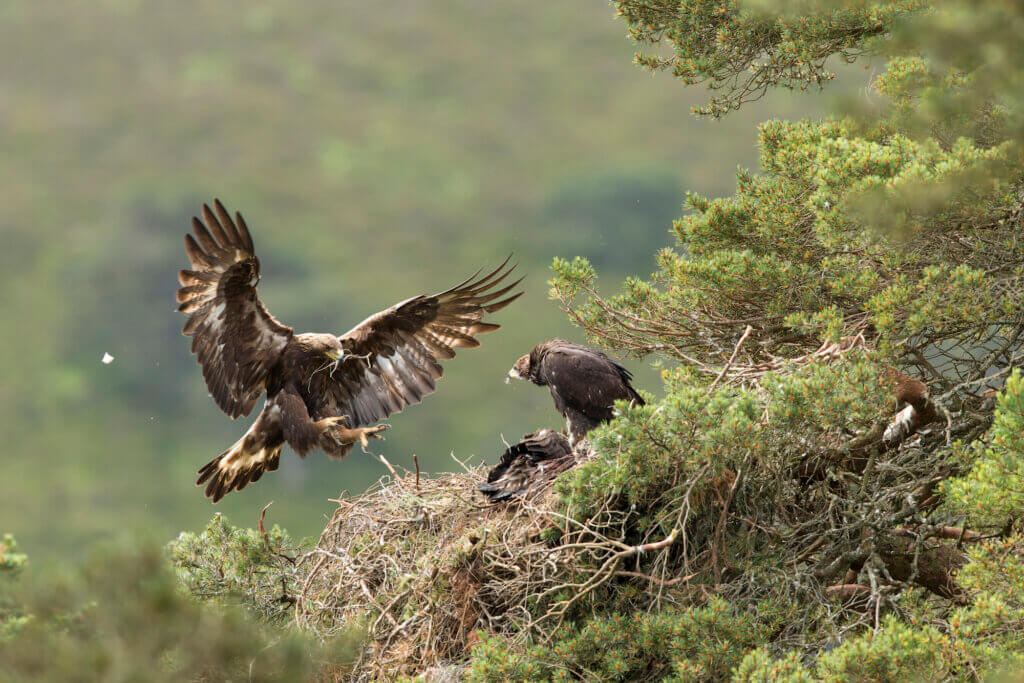Golden eagles breed at Highlands rewilding estate for first time in 40 years

A pair of golden eagles has successfully reared a chick in an artificial nest at Trees for Life’s flagship Dundreggan rewilding estate in Glenmoriston between Loch Ness and Skye – marking the first known return of the spectacular birds of prey to breed at the Highlands site in 40 years.
The eagle chick flew from the nest for the first time last week – some five years after a Trees for Life team and renowned conservationist Roy Dennis MBE of the Roy Dennis Wildlife Foundation set up an eagle nest or eyrie at a prime location to entice the birds of prey back.
There was no certainty the project would work. Golden eagles build their own nests in remote and inaccessible places, and are highly sensitive to disturbance.
“This is a rewilding success story beyond our wildest dreams. I’ve been checking the eyrie regularly since we built it in 2015, hoping to see evidence that the eagles had returned – and now they have. As golden eagles may use their nesting sites for generations, we’re hoping they are back for the long-term,” said Doug Gilbert, Trees for Life’s Dundreggan Manager.
“Four decades without golden eagles breeding or establishing themselves in this part of our wild and beautiful Highland glen have been four decades too long.
When we built the artificial nest, we knew it was in a good location for eagles because we found the remains of an old nest at the site. We’ve been keeping our fingers crossed for the past five years, and it’s wonderful that our efforts have paid off like this.”
Golden eagles – regarded by many people as Scotland’s national bird – are regularly seen over Dundreggan, but until now there has been no sign of them nesting or setting up a territory.
Highland Raptor Study Group member and golden eagle expert Stuart Benn said: “This is terrific news – the first time golden eagles have definitely bred at Dundreggan since 1980. Eagles are undergoing a marked expansion in the Highlands just now, recolonising ground they haven’t been on for many years and even colonising some completely new areas.”
The golden eagle is the UK’s second-largest bird of prey, after the white-tailed eagle. It is native to Britain, but centuries of persecution saw it driven into extinction in England and Wales by the mid-1800s.
The bird has been making a slow recovery in Scotland – though continues to be threatened by illegal persecution, with annual reports of golden eagles being shot, poisoned or having their nests robbed. The fourth national golden eagle survey, published in 2016, showed that Scotland’s population of the birds had increased to 508 pairs, a rise of 15 percent since the previous survey in 2003.
With a massive decline in wildlife over recent decades leaving Britain one of the world’s most nature-depleted countries, the return of such apex predators – which humans have either driven to extinction or left facing a precarious future – can play a key role in helping nature get back on its feet, including by ensuring a fully functioning food chain.
Trees for Life has been rewilding Dundreggan – including by protecting and expanding fragments of the Caledonian Forest – since its 2008 purchase of the 10,000-acre former deer stalking estate.
This has included restoring golden-eagle-friendly mountaintop forests of tough, waist-high ‘wee trees’, such as dwarf birch and downy willow. Known as ‘montane’ species because they can grow near mountain summits despite harsh conditions, these once-common woodlands are now rare in Scotland following centuries of overgrazing by sheep and deer.
A marked rise in black grouse numbers as habitats have recovered has also probably helped the eagles in their breeding attempt, as these are favourite prey for eagles.
Dundreggan is home to over 4,000 plant and animal species – including some never recorded in the UK before or once feared extinct in Scotland.
In June, Trees for Life lodged a detailed planning application with Highland Council for the world’s first rewilding centre at Dundreggan, which it plans to open in 2022. The charity expects to welcome over 50,000 visitors annually – allowing people to explore the wild landscapes, discover Gaelic culture, and learn about the region’s unique wildlife.
Trees for Life is dedicated to rewilding the Scottish Highlands. Its volunteers have established nearly two million native trees at dozens of sites, encouraging wildlife to flourish and helping communities to thrive. See www.treesforlife.org.uk.
Ends
[registration_form]
Great news.
https://www.bbc.co.uk/news/science-environment-53755630
Just covered on the BBC4 Today programme. 0845ish!
50,000 visitors annually at a rewilding site. Those visitors will have to stay somewhere, they will have to eat somewhere. Some will wish to buy gifts and books etc. Jobs will be created in hospitality and retail. Guides will be wanted as will wardens. MONEY will be made! Taxes will be paid.
What is it about the above that the Scottish government don’t get? What is it about the above that landowners do not understand?
Or is it simply that those 50,000 accents will be more Forth Bridge than Oxbridge, more brummie than plummie.
Next time the SG say they can’t afford something, we will know that it is because they favour grouse over tourists.
All this on a 10,000 acre estate. How many estates in Scotland?
Scotland can no longer rely on oil income. Like grouse shooting, it’s in its death throws. Time to get real.
Absolutely there is no doubt that live wildlife will make much more tax income in the long term than shooting grouse or deer. It will also create more jobs than a few gamekeepers and seasonal beaters, plus those jobs will not be creating wildlife crime statistics. Time we got rid of the Victorian pastimes and entered a truly modern era.